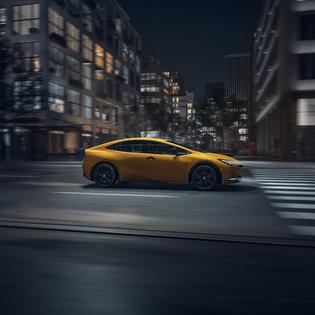Eric's Autos: 2025 Toyota Prius
Imagine going back in time to the heyday of the V8 muscle car in the late 1960s and early '70s with a brand-new Prius hybrid -- and beating almost all of them in a drag race.
While averaging close to 60 mpg.
That's what you might call a have-your-cake-and-eat-it-too situation.
What It Is
The Prius is -- as everyone knows -- a hybrid designed to use as little gas as possible. The latest version of this compact five-door hatchback uses less gas than any prior Prius -- averaging 57 miles mpg.
It is also the most powerful -- and quickest -- Prius ever.
And the least Prius-looking Prius ever, on top of that.
Prices start at $28,350 for the base LE trim, which comes standard with 17-inch wheels, climate control, LED headlights, digital dashboard and an 8-inch touch screen.
The next-up XLE trim ($31,795) adds 19-inch wheels -- which add rolling resistance and thereby reduce the Prius' fuel economy significantly, to 52 mpg -- but gets heated synthetic leather seats, a heated steering wheel and backseat cupholders. This trim is also eligible for the optional all-wheel drive system, which increases the price to $33,195.
The Nightshade trim ($32,560) is available in fly yellow exterior paint with black anodized 19-inch wheels.
This trim is also available with AWD ($33,960).
A top-of-the-line Limited lists for $35,365 for the front-drive version and $36,765 for the AWD version. This most luxurious version of the 2025 Prius includes the XLE's equipment plus a power liftgate, ventilated front seats and a premium eight-speaker JBL audio system.
What's New for 2025
The Nightshade trim is new for this model year.
What's Good
-- Standard Prius averages close to 60 mpg -- and can get to 60 mph in about six seconds.
-- No longer looks like Mrs. Doubtfire's Prius.
-- Though it's a small car, the hatchback layout allows more cargo room (23.8 cubic feet) than any full-size car on the market.
What's Not So Good
-- 5 mpg penalty if you opt for any trim besides the base LE, due to the other trims all coming standard with wheels two sizes larger, which increases weight and rolling resistance.
-- AWD is only available with the XLE and higher (more expensive) trims.
-- Costs about $3,000 more to start than a Hyundai Elantra hybrid.
Under the Hood
Regardless of trim, every Prius comes standard with a 2.0-liter four-cylinder engine augmented by a hybrid system that shares the load of propelling the car and powering the accessories when the engine isn't running -- which is as often as possible, to conserve gas.
The combo touts 194 horsepower -- which for some historical context is almost exactly as much power (a little more, actually) as was touted by a circa 1984 Chevy Camaro Z28 equipped with a 5.0-liter "high-output" V8 that touted 190 horsepower.
It did not average 57 mpg.
Nor did it get to 60 mph in six seconds. The new Prius does.
A continuously variable transmission is standard, as is front-wheel drive. AWD is available optionally in every trim except the base LE. The base LE is also the only Prius trim that averages 57 mpg because it is the only Prius trim that comes standard with 17-inch (rather than 19-inch) wheels. The two-sizes-larger wheels exact a 5 mpg fuel efficiency penalty, but you'll still average 52 mpg, which is nearly as good as the prior Prius -- which was only packing 1.8 liters and 121 horsepower.
It touted 58 mpg city/53 mpg highway. But it did not tout the ability to get you from zero to 60 mph in about six seconds. It took the prior Prius about 10 seconds -- about four seconds longer than the new Prius takes.
The prior Prius was also not available with AWD -- probably because that would have made it take even longer to get to 60 mph.
On the Road
It's a little strange -- but in a good way -- to drive a Prius that's quick. It's kind of like getting back into shape by eating stacks of pancakes and syrup.
What's not to like?
Well, one thing -- already mentioned -- which is that the Prius could be even quicker and would probably be able to get to 60 mph even sooner if it were shod with 15-inch rather than 17-inch wheels. Losing the weight -- and the rolling resistance -- would do that and at little if any cost. There might be a slight decrease in all-out cornering grip, and perhaps braking distances in panic-stop situations would increase a bit. But should either be a prime consideration for a car such as this?
The fact is, an '80s-era Z28 Camaro only had 16-inch wheels -- and it was a high-performance (and V8-powered) car. And it handled -- and stopped -- quite well. This strange business of shoeing even cars that are -- ostensibly -- meant to achieve the highest possible fuel economy with huge "rims" is as strange a thing as it was for men to walk around with codpieces back in the 1500s. It's all for show -- and it's not a very good look, either.
What's good is the power/performance to spare this Prius comes standard with. All the old jokes no longer apply. This thing is quicker than most modern cars/crossovers. You don't have to build a head of steam to match the speed of traffic you're trying to merge with -- and you now have the oats to pull into traffic from a side road without needing to wait for a gap in traffic 100 yards long, to avoid risking someone pile-driving into your Prius from behind because the thing couldn't get out of its own way.
Another not-so-obvious benefit of the power to spare is that the CVT doesn't feel (or sound) like one. It did before -- because the prior Prius lacked power to spare, so it was often necessary to use just about all there was -- just to get it going. The CVT enhanced the feel (and sound) of the underpowered engine because that's what CVTs do when they are paired with underpowered engines. They let the engine rev to its power peak -- to make use of what power there is -- and hold it there, which makes a racket and doesn't feel good either.
This Prius isn't like that. Plus, Toyota's CVTs are much better -- in terms of how they feel and sound -- than most other CVTs because they have a first gear/"launch" gear like a regular automatic. This also likely makes them more durable and long-lived.
As before, there are selectable drive modes that can be used to tweak the responsiveness -- or the economy -- of the hybrid drivetrain, as well as an electric vehicle mode that allows low-speed driving on batteries for short distances, assuming the battery pack has recovered enough charge. This version of the Prius charges itself as you drive -- using the gas engine and the kinetic energy of motion via regenerative braking. There is also a plug-in version of the Prius that can be charged externally. It will be reviewed separately.
At the Curb
When the original Prius came out almost 25 years ago, Toyota styled it to look different -- in a "Mrs. Doubtfire" kind of way. There's no doubt the new Prius looks nothing like the kind of car that Robin Williams' character in that movie drives. In fact, it looks so much unlike the original Prius that you'd never know it was one if it didn't have the badge to let you know.
It's sleek and even sexy, two attributes Mrs. Doubtfire's car did not possess.
And it is a much larger car. As well as more roomy in every way, which you might not think it would be given its sport sedan looks. The OG Prius -- back in 2001 -- was just 169.6 inches long -- qualifying it as a subcompact -- and had room for only whatever would fit inside its 11.6-cubic-foot cargo area. The '25 Prius is 181.1 inches long (about a foot longer than the OG) and has room for twice as much stuff in its 23.8-cubic-foot cargo area.
But the really surprising thing -- based on looks -- is that the '25 has about the same headroom up front and in back, even though it looks like it sits much lower to the ground. More finely, that it looks like it has a much lower roofline. Which it does. The new Prius' roof is both sleekly swept back and just 55.9 inches off the ground. The OG Prius stood 57.6 inches tall and looked like it stood taller.
The nut of it is that -- mirroring the way Toyota managed to make the new car almost twice as quick as the OG Prius getting to 60 mph while also increasing its fuel economy -- the new Prius is also a more practical (that is, roomier) car than the OG Prius as well as a car that does not conjure up images of Mrs. Doubtfire.
Toyota also does an excellent job here -- as in its other models -- of avoiding the pratfall of all-touch/all-swipe control interfaces. There is an LCD touch screen, of course. But there is still a manual (rotary control) knob for increasing or decreasing the volume of the sound system, with a secondary/redundant switch on the steering wheel. There are also toggles for the seat heater controls and the climate controls too.
A neat feature built into the center console is a slot charger-holder for your phone that holds it in place so it doesn't slide all around the place; it's off to the right of the gear selector -- which emulates the look and feel of the traditional style rather than the OG Prius' toggle style. Another -- subtler -- feature is the way the dash is made to be low, which very much increases forward visibility. It also makes you feel as if you are driving a jet fighter.
A feeling that's enhanced when you floor it.
The Rest
The new Prius is also not as pricey as the OG Prius -- at least in terms of what today's dollars buys versus what they did back in 2001. Back then, a new Prius listed for just shy of $20,000 -- about $36,000 today. Put another way, the '25 Prius is about $7,500 less expensive to buy than the OG Prius -- in addition to being more economical to drive. It just feels more expensive to buy it -- because of the having to spend more devalued dollars to buy it.
If you're wanting something that costs less but still gets great mileage, you may want to look at the Hyundai Elantra hybrid -- which lists for $25,450 to start and touts 51 mpg city, 58 mpg highway. But it only has 139 horsepower on tap, all told -- which makes it about as quick as a 2001 OG Prius.
Another option is the Honda Civic hybrid -- which touts 200 horsepower (just slightly more than the new Prius) but costs a little more than the Prius, with a base price of $28,950, and only manages 50 mpg in city driving and 47 mpg on the highway, the latter being much lower than the Prius can deliver -- at least the base LE trim with the lower-rolling-resistance 17-inch wheels.
The Bottom Line
It's said you cannot have your cake and eat it too. The latest Prius proves that's not always the case.
========
Eric's latest book, "Doomed: Good Cars Gone Wrong!" will be available soon. To find out more about Eric and read his past columns, please visit the Creators Syndicate webpage at www.creators.com.
Copyright 2025 Creators Syndicate, Inc.








Comments